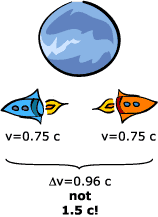| |
 |
Imagine that you are standing between
two space-ships moving away from you. One space-ship
moves to the left with a speed of 0.75 c (relative
to you) and the other one moves to the right also
with a speed of 0.75 c (relative to you).
At what speed will each space-ship see the other
moving away? 0.75 c + 0.75 c = 1.5 c?
No, their relative speed will be 0.96 c (according
to the relativistic addition of velocities), and it
cannot, of course, be faster than the speed of light c. |
|
|
|
In classical Newtonian mechanics,
two different velocities  and and  are added together
by the formula are added together
by the formula
 , ,
where  is the sum of the two velocities. However,
in special relativity, the velocities are added together
as is the sum of the two velocities. However,
in special relativity, the velocities are added together
as
 . . |
This formula is called the relativistic addition of velocities.
Note that if  = c and/or = c and/or  = c, then = c, then  = c, and for small velocities = c, and for small velocities  , ,  << c, then
the classical formula is regained. << c, then
the classical formula is regained.
|